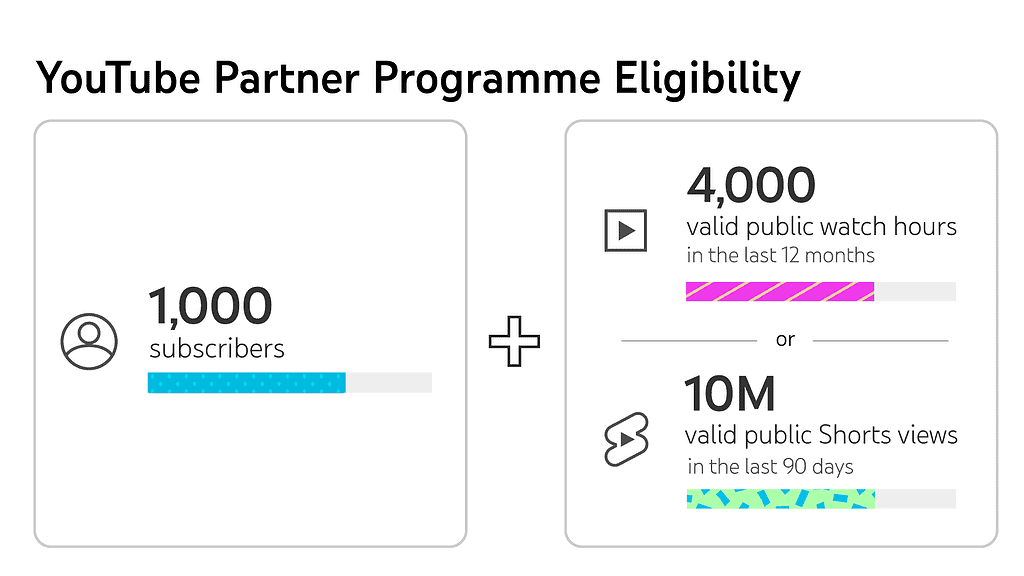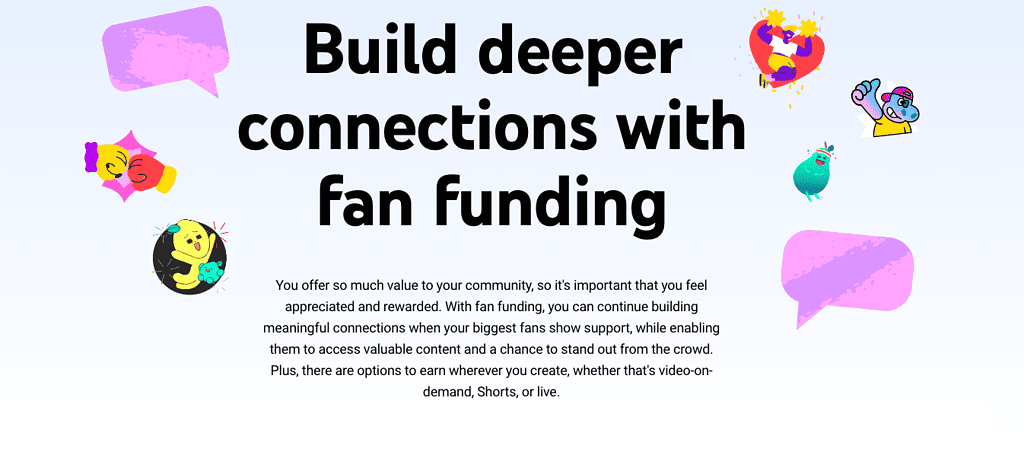How to Make Money on Youtube-The Ultimate Guide!
Are you tired of scrolling through your favorite YouTube channels, wondering how YouTubers make a living doing what they love? Are you ready to take the plunge and turn your hobby into a profitable career? If so, you’ve come to the right place. Welcome to the ultimate guide on “How to Make Money on Youtube.”
With over 2 billion monthly active users, Youtube is the world’s largest video-sharing platform. And with the right strategies, it can also be a lucrative one. In this guide, we’ll explore the various ways YouTubers can monetize their content, from joining the Youtube Partner Program to becoming an affiliate marketer. We’ll also cover how many views you need to start making money and how much money YouTubers typically make per year.
But before we dive into the specifics, let’s take a step back and discuss why making money on Youtube is worth pursuing. For starters, creating content on Youtube allows you to share your passions with the world, build a community of like-minded individuals, and establish yourself as an authority in your niche. Not to mention, the potential to earn a full-time income doing something you love is a dream come true.
So, if you’re ready to turn your Youtube channel into a money-making machine, keep reading. We’ll walk you through everything you need to know, step by step.
How do you make money on YouTube or How to get monetized on YouTube?
There are several ways to make money on YouTube. Here are some of the common methods:
1. Join the YouTube Partner Program

Joining the YouTube Partner Program can be a game-changer for creators looking to monetize their content. But before you start dreaming of dollar signs, let’s go over what it takes to join the program.
To qualify for the program, your channel must have at least 1,000 subscribers and 4,000 watch hours within the past 12 months. Once you’ve hit these thresholds, you can apply for the program through your channel settings.
Once you’re accepted into the program, you’ll have access to a range of monetization options. The most common way creators earn money through the program is through ad revenue. This is when ads are displayed on your videos and you earn a portion of the revenue generated by those ads.
In addition to ad revenue, the program also allows creators to offer channel memberships. This is a way for fans to support creators by paying a monthly fee in exchange for exclusive perks like behind-the-scenes content, early access to videos, and custom badges and emojis. Another monetization option is Super Chat, which allows viewers to pay to have their comments highlighted during a live stream.
To optimize your content for monetization, there are a few key things to keep in mind. First, use relevant keywords in your titles, descriptions, and tags to help your videos surface in search results. Second, create engaging titles and thumbnails that entice viewers to click on your videos. And third, optimize your video length to maximize watch time.
For example, if you’re creating a tutorial video, aim for a length that’s long enough to cover all the necessary information but short enough to keep viewers engaged. And if you’re creating a vlog, consider breaking it up into shorter segments that are easier for viewers to consume.
2. Sell Products or Merchandise
Want to know how to turn your YouTube channel into a money-making machine? Well, selling products or merchandise is one way to do it! Not only can you monetize your content, but you can also promote your own physical or digital products to your highly engaged audience. It’s a win-win!
To get started, you can include links to your products in your video descriptions, making it easy for your viewers to find and purchase them. And if you really want to take things to the next level, you can even use YouTube’s built-in merch shelf to showcase your products directly on your channel. It’s like having your own online store but with the added bonus of having a built-in audience.
One of the best things about selling products on YouTube is that you can earn more revenue per sale than through traditional retail channels. That’s because you cut out the middlemen, allowing you to keep more of the profits. And since your subscribers and viewers are already interested in your content, they are more likely to buy products that align with their interests.
Need some inspiration? Check out beauty guru Michelle Phan, who has her own makeup line, or fitness influencer Cassey Ho, who sells workout clothes and equipment on her channel. These creators have built a loyal following and leveraged their influence to sell products that align with their brand. So, why not give it a shot? Who knows, you might just find a whole new source of revenue for your channel!
3. Crowdfund Your Next Creative Project
Crowdfunding has become an increasingly popular way for creatives to fund their passion projects. Platforms like Kickstarter and Patreon allow content creators to raise money directly from their fans, either for a specific project or as ongoing support.
The benefits of crowdfunding are clear: it gives creators the freedom to pursue their passions without relying on traditional sources of funding like grants or investors. Plus, crowdfunding can provide creators with a sense of community and support from their fans.
However, it’s important to note that crowdfunding isn’t a guaranteed path to success. Running a successful campaign requires a lot of work and a large and engaged fan base. Plus, there’s always the risk that a campaign will fall short of its funding goal, leaving the creator with nothing.
If you’re thinking about launching a crowdfunding campaign, here are some tips to help you succeed:
First, set clear and achievable goals for your campaign. This means determining exactly what you need the funding for, how much money you need to raise, and what rewards you’ll offer to backers.
Next, create compelling rewards that will entice people to support your campaign. These could be anything from exclusive content to personalized merchandise.
Finally, engage with your backers throughout the campaign and beyond. Keep them updated on your progress and show them how their support is making a difference in your creative work.
To give you an idea of how crowdfunding can work, let’s look at some real-life examples. Take the YouTube channel Kurzgesagt, for example. They used Patreon to raise over $5 million in ongoing support from their fans, which has allowed them to create high-quality, educational videos on a regular basis.
4. Let Your Audience Support You Through “Fan Funding”

In addition to crowdfunding, another way to earn money from your YouTube channel is through fan funding. This feature allows viewers to make voluntary donations to support your work, either through a one-time payment or ongoing monthly support.
One of the benefits of fan funding is that it allows you to receive ongoing support from a loyal audience. This can provide creators with a more stable source of income than relying solely on ad revenue, which can fluctuate based on factors outside of their control.
Another advantage of fan funding is that it can potentially earn you more revenue than traditional ad revenue. This is because fans who are willing to donate are often more invested in your content and are more likely to share it with others, which can help grow your audience and increase your revenue over time.
Some successful YouTubers who have used fan funding include gaming channels like PewDiePie and Markiplier, as well as educational channels like Crash Course and SmarterEveryDay. By offering exclusive content or perks to their supporters, these creators have been able to earn a significant amount of income through fan funding.
To enable fan funding on your channel, simply go to your YouTube Dashboard and select “monetization.” From there, you can set up a fan funding button that will appear on your channel and allow viewers to donate directly to you.
Overall, fan funding can be a great way to supplement your income as a creator and build a stronger connection with your audience. Just remember to offer something of value in return for their support, whether it’s exclusive content or simply a heartfelt thank-you message.
5. License Your Content to the Media
Another way to monetize your YouTube content is by licensing it to media outlets, such as news organizations or TV shows. By allowing others to use your content in their programming, you can potentially earn money and gain increased exposure for your channel.
The benefits of licensing your content include the potential for increased revenue through licensing fees, as well as exposure to a wider audience through media outlets that may not have discovered your channel otherwise. Additionally, licensing can be a great way to build your reputation and establish yourself as a professional content creator.
To find potential media outlets to license your content to, start by researching relevant news organizations or TV shows that cover topics similar to your content. Reach out to these outlets and offer to license your content for use in their programming. Be sure to negotiate the terms of the license agreement, including any fees and how your content will be used.
It’s also important to protect your intellectual property rights when licensing your content. This means clearly stating in the license agreement how your content can be used and ensuring that the media outlet adheres to these guidelines.
Successful YouTubers who have licensed their content to media outlets include Casey Neistat, who has worked with brands like Samsung and Mercedes-Benz, and Felix Kjellberg (PewDiePie), whose videos have been featured on TV shows like South Park and The Late Show with Stephen Colbert.
Overall, licensing your content to media outlets can be a great way to monetize your YouTube channel and gain increased exposure to your content. Just be sure to negotiate fair terms and protect your intellectual property rights along the way.
6. Work with Brands as an Influencer
Influencer marketing is a rapidly growing trend, and creators on YouTube can leverage their audience to partner with brands and monetize their content. Brands are always looking for ways to reach new audiences, and influencers can provide a valuable platform for them to do so.
There are different types of partnerships that influencers can enter into with brands, including sponsored content, affiliate marketing, and product reviews. Sponsored content involves creating content that promotes a brand or product, while affiliate marketing involves earning a commission for promoting a brand’s products or services. Product reviews involve providing an honest evaluation of a brand’s product in exchange for compensation or free products.
To approach brands and negotiate partnerships, it’s important to have a clear understanding of your audience and what kind of partnerships would be a good fit for your channel. Be transparent with your audience about any sponsored content or partnerships, and maintain authenticity by only partnering with brands that align with your values and content.
When approaching brands, be prepared to pitch your value proposition and explain why partnering with you would be beneficial for their business. It’s also important to negotiate fair compensation for your work, including payment and any additional perks or benefits.
Successful YouTubers who have worked with brands as influencers include Zoella, who has partnered with brands like Dove and L’Oreal, and Lilly Singh (IISuperwomanII), who has worked with Coca-Cola and Calvin Klein.
Overall, working with brands as an influencer can be a great way to monetize your YouTube channel and create valuable partnerships with businesses. Just be sure to maintain transparency and authenticity with your audience, and negotiate fair compensation for your work.
How Many Views Do You Need on YouTube to Make Money?
When it comes to making money on YouTube, the number of views your videos receive is just one piece of the puzzle. Other factors, such as your content’s niche or topic and the monetization methods you use, can also play a role in your earnings.
For example, a YouTuber who creates videos on a highly profitable niche, like finance or technology, may earn more money per view than a creator who makes videos on a less profitable topic, like knitting or painting. Similarly, the monetization methods you use, such as running ads or selling merchandise, can also impact your earnings.
Calculating your potential earnings on YouTube is easy thanks to the platform’s built-in analytics tools. These tools allow you to see how many views your videos are getting, how long viewers are watching them, and how much revenue you’re earning from ads. You can use this information to estimate your potential earnings and make adjustments to your content or monetization strategies as needed.
Successful creators on YouTube come in all shapes and sizes, with varying levels of views. For example, the channel “Toy Freaks” had only 6 million subscribers but earned over $1 million per year thanks to its highly profitable niche (children’s toys). On the other hand, PewDiePie, who has over 110 million subscribers, earned an estimated $30 million in 2020 through a combination of ads, sponsorships, and merchandise sales.
There are numerous examples of successful creators who have achieved financial success on YouTube with varying levels of views. For example, MrBeast, a popular YouTuber known for his stunts and challenges, has over 70 million subscribers and earns millions of dollars through merchandise sales, sponsorships, and ad revenue. On the other hand, smaller channels with fewer than 100,000 subscribers can also earn a decent income by focusing on their niche, building a loyal audience, and diversifying their revenue streams.
How Much Money Do YouTubers Make Per Year?
When it comes to how much money YouTubers can make per year, there’s a wide range of possibilities. Some creators may only earn a few hundred dollars per year, while others can make millions. The amount of money you can earn on the platform depends on several factors, including your niche, audience size, and monetization strategy.
Let’s look at some specific examples of successful YouTubers and their annual earnings. PewDiePie, one of the most well-known YouTubers, reportedly earned $13 million in 2019. Meanwhile, channels in the beauty and makeup niche, such as Jeffree Star and James Charles, have also seen significant financial success, with earnings in the millions of dollars per year.
However, it’s important to remember that not all successful YouTubers are household names. There are many lesser-known creators who are able to make a comfortable living from their channels. For example, creators in niche markets like woodworking or cooking may not have millions of subscribers, but they can still earn a steady income from their loyal fanbase.
It’s also important to note that income potential on YouTube can grow over time, but it takes consistent effort and hard work. You’ll need to consistently create high-quality content that resonates with your audience and continuously engage with your fans to grow your channel.
Ultimately, the amount of money you can make on YouTube is determined by several factors, including your niche, audience, and monetization strategy. While some creators have achieved massive financial success, there are also many lesser-known channels that are able to make a comfortable living from their content. Regardless of your goals, building a successful YouTube channel takes time, dedication, and hard work.
Conclusion
Becoming a successful creator on YouTube takes time, effort, and dedication. While it’s tempting to focus solely on the potential for financial gain, it’s important to remember that creating content should be about more than just making money.
By staying true to your interests and passions, and consistently producing quality content that resonates with your audience, you can build a loyal following and potentially earn a substantial income.
Whether you’re just starting out or have been creating content for a while, there are always opportunities to grow and improve. So keep learning, experimenting, and pushing yourself to create your best work.
Who knows? You could be the next YouTube success story.
How to Make Money on Youtube FAQs
How much does YouTube pay?
YouTube pays its creators a portion of the revenue generated from ads that run on their videos. The amount a creator earns per view varies depending on a number of factors, including the type of ad, the viewer’s location, and the creator’s engagement rate. On average, creators earn around $0.018 per view, which amounts to $18 for every 1,000 views. However, some creators can earn much more than this, while others may earn less.
How much money can you make on YouTube?
The amount of money you can make on YouTube varies widely and depends on various factors. Some successful YouTubers earn millions of dollars annually, while others may only generate a small income or no income at all. Here are a few examples to give you an idea of the potential range:
1. Low earnings: Many YouTubers who are just starting or have a small audience may earn very little from their videos. This could be a few dollars to a couple of hundred dollars per month.
2. Moderate earnings: As a channel grows and starts to gain more views and subscribers, the earnings can increase. Depending on the niche, engagement, and content quality, YouTubers in this category might earn several hundred to a few thousand dollars per month.
3. High earnings: Highly successful YouTubers with millions of subscribers and a significant amount of views can generate substantial income. Their earnings can reach hundreds of thousands or even millions of dollars per year. However, it’s important to note that these cases represent a small percentage of YouTubers.
How to make money on YouTube without making videos?
While YouTube is primarily known as a platform for sharing video content, there are a few ways you can potentially make money on YouTube without creating videos yourself. Here are some options to consider:
Become an affiliate marketer: You can create a YouTube channel focused on reviewing or recommending products and include affiliate links in the video descriptions. When viewers click on those links and make a purchase, you earn a commission from the affiliated company.
Curate content:
Instead of creating your own videos, you can curate and compile existing videos into playlists or compilations on your YouTube channel. This could include compilations of funny moments, educational content, or any other theme that resonates with your target audience. Ensure that you have the necessary rights and permissions to use the content.
License and sell footage: If you have access to high-quality footage or stock videos, you can upload them to YouTube and license them for use in other people’s videos. Platforms like the YouTube Partner Program and Content ID allow you to monetize your footage and earn revenue when others use it in their videos.
Manage a YouTube channel: Some content creators may not have the time or expertise to manage their YouTube channels effectively. You can offer your services as a channel manager, handling tasks such as video editing, keyword optimization, thumbnail creation, community engagement, and other aspects of channel management. You can negotiate a fee or revenue-sharing arrangement with the channel owner.
Provide consulting or coaching services: If you have expertise in a particular niche or area related to YouTube, you can offer consulting or coaching services to aspiring YouTubers. This can include providing guidance on content strategy, video optimization, audience engagement, and monetization strategies.
It’s important to note that while these methods can potentially generate income, they still require effort, time, and skills to succeed. Building an audience, developing relationships with brands or creators, and consistently delivering value are crucial aspects of any monetization strategy on YouTube.
How many subscribers do you need to make money YouTube?
To make money on YouTube, you need to meet certain eligibility criteria and join the YouTube Partner Program (YPP). As of my knowledge cutoff in September 2021, the following requirements must be fulfilled:
1,000 subscribers: You need to have at least 1,000 subscribers on your YouTube channel.
4,000 watch hours: Your channel should have accumulated a minimum of 4,000 watch hours over the past 12 months.
Adherence to YouTube’s policies: You must comply with all of YouTube’s policies and guidelines, including copyright and community guidelines.
Once you meet these requirements and become a member of the YouTube Partner Program, you can monetize your content and start earning money from various revenue streams, including ad revenue, channel memberships, Super Chat, and YouTube Premium revenue.




![Pros and Cons of Dropshipping in [year] 6 pros and cons of dropshipping](https://www.smartsourav.com/wp-content/uploads/2023/02/Pros-and-Cons-of-Dropshipping-768x512.jpeg)
![Best Work from Home Jobs Without Investment in [year] 7 highest paying work from home jobs without a degree](https://www.smartsourav.com/wp-content/uploads/2022/10/highest-paying-work-from-home-jobs-without-a-degree-1-768x512.webp)

